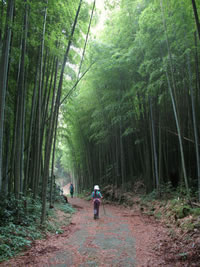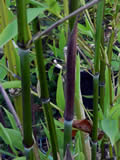- Home ›
- Bamboo Plants ›
- Bamboo Windbreak
Bamboo Windbreak
Bamboos make excellent domestic garden or commercial windbreaks and can be cultivated, cut or trimmed in the same way as you would do with a traditional hedge or screen.
Wind Force Reduction

The main purpose of a windbreak is to weaken or break the force of the wind and provide shelter and protection to whatever is behind it.
Windbreaks made from plants such as bamboos are more suitable for this purpose as they reduce the wind force rather than attempt to stop it.
The thicker the depth of a grove of bamboos, from front to back, the better the reduction in wind force is provided.
It is the unique qualities of a bamboo windbreak that makes it ideal for reducing the force of wind.
As an Amazon Associate I earn from qualifying purchases.
Flexibility

It is a very flexible plant and will bend and sway in the strongest wind speeds with only the very youngest culms suffering damage.
They are likely to bend in the wind as opposed to blowing over.
Bamboos have the ability to bend to ground level under the weight of snow, ice, or heavy rains, and high winds, then straighten back up to their full height once the conditions have eased.
Root Mass
A mature grove has a root mass that maintains anchorage in the ground in extreme weather conditions.
This means it is unlikely to cause damage or a danger to people as it does not get uprooted in the same way as individual trees in gales, hurricanes, and tornados.
Stability
The stability of a bamboo windbreak or grove has reportedly offered protection to people and property in extreme weather conditions, the highest winds, and even in earthquakes.
It is said that in some countries the bamboo groves offer protection in the event of an earthquake due to the root mass stabilizing the earth and offering a low risk of danger through culms falling and causing injury.
Added Benefit
A good bamboo windbreak will also provide shade and moisture on those days when it isn't windy!
Cultivation

To cultivate a bamboo windbreak, the first thing to do is assess the finished height and depth you require. It's important to choose a species that has a height rating to suit your requirements and a thicker depth will offer better wind speed reduction.
You can always trim a taller species down to the height you want but if the species doesn't have a high growth habit in the beginning it is not going to achieve the results you want. See my sections on pruning bamboo and trimming bamboo.
Start by deciding on the height, colour, density, and leaf size that will be suitable for your location or garden design.
Also consider how you are going to control the growth of your windbreak and/or contain it in the desired area. See my section on control and containment for a guide on these methods.
Bamboo for sale on Amazon #ad As an Amazon Associate I earn from qualifying purchases.
For more information on cultivation and care... see
Species
The bamboo listed below are some of the species that make good windbreaks. Windbreaks are good for protecting your vegetable garden in exposed locations along with providing some dappled shade where needed.

Phyllostachys - Genus List
Phyllostachys angusta 'Stone Bamboo' - Very rare species that makes excellent windbreaks and screening with aggressive spreading - edible shoots - Maximum height: 22' - Maximum diameter: 1 1/4"
Phyllostachys bambusoides 'White Crookstem' - Rare - high branching and provides excellent windbreaks and screening with aggressive spreading - edible - Maximum height: 48' - Maximum diameter: 3"
Phyllostachys bambusoides 'Giant Japanese Timber Bamboo' - Makes an excellent high branching bamboo windbreak or screens with aggressive spreading - highly prized and valued for culms that are straight, and have thick walls that can be split- Maximum height: 72' Maximum diameter: 6"
Phyllostachys decora 'Beautiful Bamboo' - Excellent for windbreaks or screens with aggressive spreading - Good performer under the stress of desert heat, cold and drought of some climates - Maximum height: 30' Maximum diameter: 1 3/4"
Phyllostachys dulcis 'Sweetshoot Bamboo' - Excellent for high branching windbreaks or screens with moderate spreading- edible with particularly nice sweet taste, popular to cultivate for its shoots - Maximum height: 40' Maximum diameter: 2 3/4"
Phyllostachys edulis Moso 'Anderson clone' - Also called Phyllostachys pubescens and Phyllostachys edulis - Excellent high branching bamboo windbreak or screen with moderate spreading - largest of the hardy bamboos - one of the most used bamboos in China for food, timber, paper, plywood, flooring and many other uses - Hardy to - 6 ° F - Maximum height: 75' - Maximum diameter: 7"
Phyllostachys elegans 'Elegant Bamboo' - Excellent high branching for windbreaks and screens with moderate spreading - edible and prized for shoots - culms used for tools. Maximum height: 32' - Maximum diameter: 2 1/4"
Phyllostachys glauca - High branching and makes excellent ornamental windbreaks and screens with aggressive spreading - edible new shoots - can withstand dry and poor soils - Culms used for woven products and fishing rods - Maximum height: 34' - Maximum diameter: 2"
Phyllostachys rubromarginata - High branching and excellent for windbreaks and screens with aggressive spreading - tolerant of cold dry winds - edible shoots - good quality wood - Culms can be split for weaving - Maximum height: 55' Maximum diameter: 2 3/4"
Phyllostachys viridis 'Houzeau' - Excellent high branching for windbreaks and screens with aggressive spreading - Maximum height: 45' Maximum diameter: 3"
Phyllostachys viridis 'Robert Young' - Excellent high branching for an ornamental bamboo windbreak or screen with aggressive spreading - popular bamboo with a striking appearance as culms and branches turn a gold colour - edible shoots - used for crafts - Maximum height: 40' - Maximum diameter: 3"
Phyllostachys vivax (species list) - High branching and excellent for ornamental windbreaks and screens with moderate spreading - grey and green colour when mature - most cold hardy of the large timber bamboos and fast to establish - edible shoots - Maximum height: 65' - Maximum diameter: 5"
Pseudosasa - Genus
Semiarundinaria - Genus, smaller running bamboos
Semiarundinaria yashadake 'Kimmei'
Bamboo for sale on Amazon #ad As an Amazon Associate I earn from qualifying purchases.